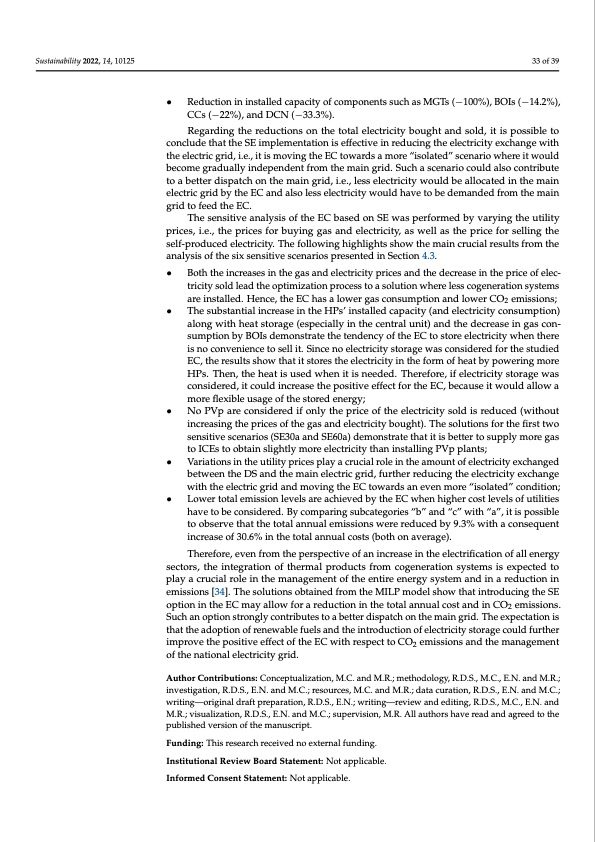
PDF Publication Title:
Text from PDF Page: 033
Sustainability 2022, 14, 10125 33 of 39 • Reduction in installed capacity of components such as MGTs (−100%), BOIs (−14.2%), CCs (−22%), and DCN (−33.3%). Regarding the reductions on the total electricity bought and sold, it is possible to conclude that the SE implementation is effective in reducing the electricity exchange with the electric grid, i.e., it is moving the EC towards a more “isolated” scenario where it would become gradually independent from the main grid. Such a scenario could also contribute to a better dispatch on the main grid, i.e., less electricity would be allocated in the main electric grid by the EC and also less electricity would have to be demanded from the main grid to feed the EC. The sensitive analysis of the EC based on SE was performed by varying the utility prices, i.e., the prices for buying gas and electricity, as well as the price for selling the self-produced electricity. The following highlights show the main crucial results from the analysis of the six sensitive scenarios presented in Section 4.3. • Both the increases in the gas and electricity prices and the decrease in the price of elec- tricity sold lead the optimization process to a solution where less cogeneration systems are installed. Hence, the EC has a lower gas consumption and lower CO2 emissions; • The substantial increase in the HPs’ installed capacity (and electricity consumption) along with heat storage (especially in the central unit) and the decrease in gas con- sumption by BOIs demonstrate the tendency of the EC to store electricity when there is no convenience to sell it. Since no electricity storage was considered for the studied EC, the results show that it stores the electricity in the form of heat by powering more HPs. Then, the heat is used when it is needed. Therefore, if electricity storage was considered, it could increase the positive effect for the EC, because it would allow a more flexible usage of the stored energy; • No PVp are considered if only the price of the electricity sold is reduced (without increasing the prices of the gas and electricity bought). The solutions for the first two sensitive scenarios (SE30a and SE60a) demonstrate that it is better to supply more gas to ICEs to obtain slightly more electricity than installing PVp plants; • Variations in the utility prices play a crucial role in the amount of electricity exchanged between the DS and the main electric grid, further reducing the electricity exchange with the electric grid and moving the EC towards an even more “isolated” condition; • Lower total emission levels are achieved by the EC when higher cost levels of utilities have to be considered. By comparing subcategories “b” and “c” with “a”, it is possible to observe that the total annual emissions were reduced by 9.3% with a consequent increase of 30.6% in the total annual costs (both on average). Therefore, even from the perspective of an increase in the electrification of all energy sectors, the integration of thermal products from cogeneration systems is expected to play a crucial role in the management of the entire energy system and in a reduction in emissions [34]. The solutions obtained from the MILP model show that introducing the SE option in the EC may allow for a reduction in the total annual cost and in CO2 emissions. Such an option strongly contributes to a better dispatch on the main grid. The expectation is that the adoption of renewable fuels and the introduction of electricity storage could further improve the positive effect of the EC with respect to CO2 emissions and the management of the national electricity grid. Author Contributions: Conceptualization, M.C. and M.R.; methodology, R.D.S., M.C., E.N. and M.R.; investigation, R.D.S., E.N. and M.C.; resources, M.C. and M.R.; data curation, R.D.S., E.N. and M.C.; writing—original draft preparation, R.D.S., E.N.; writing—review and editing, R.D.S., M.C., E.N. and M.R.; visualization, R.D.S., E.N. and M.C.; supervision, M.R. All authors have read and agreed to the published version of the manuscript. Funding: This research received no external funding. Institutional Review Board Statement: Not applicable. Informed Consent Statement: Not applicable.PDF Image | Optimal Sharing Electricity and Thermal Energy

PDF Search Title:
Optimal Sharing Electricity and Thermal EnergyOriginal File Name Searched:
sustainability-14-10125-v2.pdfDIY PDF Search: Google It | Yahoo | Bing
Turbine and System Plans CAD CAM: Special for this month, any plans are $10,000 for complete Cad/Cam blueprints. License is for one build. Try before you buy a production license. More Info
Waste Heat Power Technology: Organic Rankine Cycle uses waste heat to make electricity, shaft horsepower and cooling. More Info
All Turbine and System Products: Infinity Turbine ORD systems, turbine generator sets, build plans and more to use your waste heat from 30C to 100C. More Info
CO2 Phase Change Demonstrator: CO2 goes supercritical at 30 C. This is a experimental platform which you can use to demonstrate phase change with low heat. Includes integration area for small CO2 turbine, static generator, and more. This can also be used for a GTL Gas to Liquids experimental platform. More Info
Introducing the Infinity Turbine Products Infinity Turbine develops and builds systems for making power from waste heat. It also is working on innovative strategies for storing, making, and deploying energy. More Info
Need Strategy? Use our Consulting and analyst services Infinity Turbine LLC is pleased to announce its consulting and analyst services. We have worked in the renewable energy industry as a researcher, developing sales and markets, along with may inventions and innovations. More Info
Made in USA with Global Energy Millennial Web Engine These pages were made with the Global Energy Web PDF Engine using Filemaker (Claris) software.
Sand Battery Sand and Paraffin for TES Thermo Energy Storage More Info
| CONTACT TEL: 608-238-6001 Email: greg@infinityturbine.com | RSS | AMP |